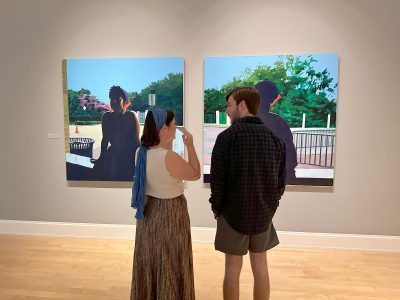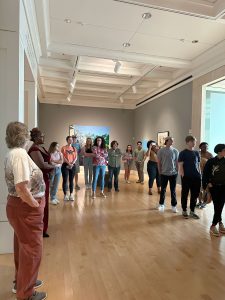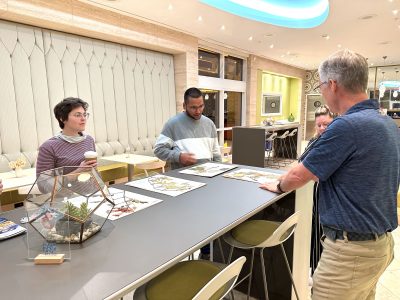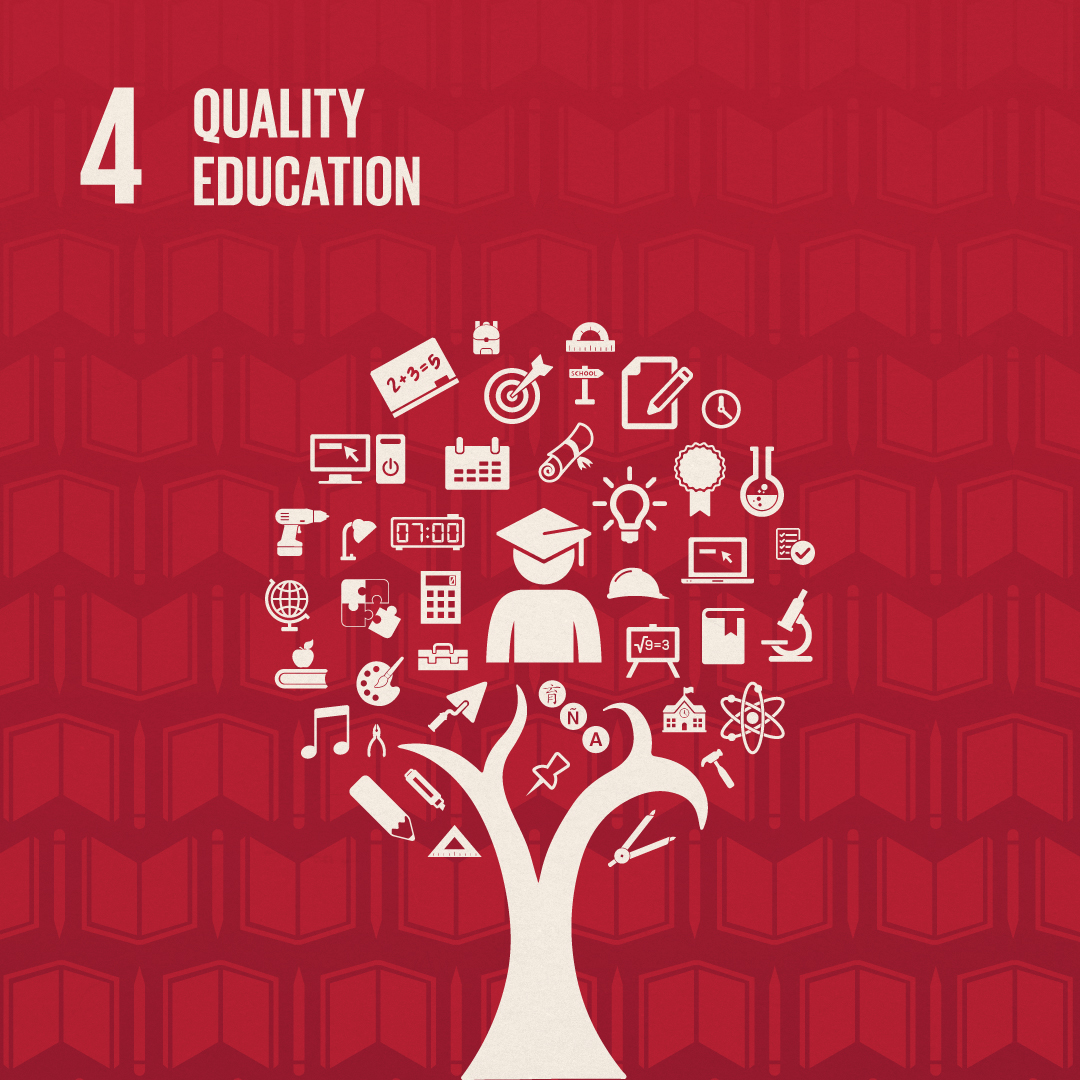By Randi Evans
A shift has been taking place among museums in the United States since the racial reckoning of 2020 and the onset of Covid-19. The number of articles written between 2020 and the present chronicle the way museums – often considered stodgy, slow-moving institutions – have worked to re-examine their relationships to their community and be more inclusive. The New York Times even has a special section dedicated to articles and continues to document this shift among museums. In the past several years, some museums have re-structured their physical spaces to allow for more community engagement, while others have shaken up their exhibitions and programming to meet community needs.
The above shifts became very apparent to me when I attended the Association of Academic Museums and Galleries conference at the University of Kansas and Spencer Museum of Art this summer. My role at the Jule Collins Smith Museum is a new one and my title isn’t without a little confusion to most people I meet (Manager of Public Practice and Community Partnerships). Yet, at the conference I met a whole cadre of individuals who hold similar roles and titles across the country. Further, what was most surprising was that the majority of those people began their position in the last few years. To me, our collective roles signaled that the changes taking place at museums are not merely reactive, but about a collective re-examination of cultural, educational, and governmental institutions across the United States
 Stepping into this new role as a transplant to the region, I began by really analyzing my new home and the surrounding area. The community of a small college town is unique as it is both transient and permanent – students and faculty may come and go, while others make a permanent home. The divide between transient and permanent populations is not unique to Auburn and is perhaps why the adage “town and gown” exists. Considering Auburn and my role, I began to question: how can the museum be a space where multiple communities can come together for reciprocal engagement – old learning from young, staff thinking alongside faculty, and more?
Stepping into this new role as a transplant to the region, I began by really analyzing my new home and the surrounding area. The community of a small college town is unique as it is both transient and permanent – students and faculty may come and go, while others make a permanent home. The divide between transient and permanent populations is not unique to Auburn and is perhaps why the adage “town and gown” exists. Considering Auburn and my role, I began to question: how can the museum be a space where multiple communities can come together for reciprocal engagement – old learning from young, staff thinking alongside faculty, and more?
Taking inspiration from these shifts among museums to be more accessible and community-center, the education team at the Jule began organizing Thursday evening discussions entitled “Common Grounds.” Almost every Thursday we invite a local community leader, scholar, artist, or student, to the museum to share their work or personal story in relationship to art in our exhibitions. Shifting expertise from museum staff to our community allows visitors to learn from one another and see how one does not need to be an art historian or specialist to have knowledge about art.

Museum visitors participating in Common Grounds.
A central component of “Common Grounds” has been using our museum space in different ways. In The Art of Gathering: How We Meet and Why it Matters, master facilitator and author, Priya Parker, writes: “In all my gatherings, whether a board meeting or a birthday party, I have come to believe that it is the way a group is gathered that determines what happens in it and how successful it is, the little design choices you can make to help your gathering soar.” Often, when one comes to a museum to hear someone speak, they expect to go to the auditorium where there is a clear divide between expert and audience. With this in mind, we made distinct design choices for “Common Grounds.” We always begin in our café where people can grab some tea or coffee and sit amongst our guest rather than separate from them. Before introducing our special guest, I always ask the people in the room to introduce themselves and what brought them there that evening. The answers are always surprising and varied – from remote workers looking for something social to do in the evening to students who are seeking extra credit to friends or colleagues of the guest. This moment of introductions, although small, has created pathways for our visitors to get to know one another. I’ve seen people stay after sessions and talk to strangers because they realize they have a shared connection.
After introductions, the featured guest shares their story or research in a way that suits them. Some people tell stories, some start a conversation, and some bring in images or physical objects to compliment what we have in the museum. For example, when Curtis Hansen, the Plants Collection Manager at the Museum of Natural History spoke, he brought plant pressings from his personal collection that were featured in the Audubon prints in our galleries. He spoke about the art of collecting and pressing plants, merging subjects that people might not see as connected.
 For me, the best part of “Common Grounds” is witnessing the amount of learning and exchange that takes place when looking at art together. I was heartened to see intergenerational learning when a student whose class created work inspired by one of our exhibitions shared her final project. An elderly woman was one of the attendees that evening and took great interest in the student’s work asking questions and offering feedback. Another time, when looking at the work of Kevin Brisco, a community member pointed out that one of his pieces featured the lyrics of a 2Pac song. I would have never realized this without this community member’s comments, and it changed how I viewed and shared the work with others.
For me, the best part of “Common Grounds” is witnessing the amount of learning and exchange that takes place when looking at art together. I was heartened to see intergenerational learning when a student whose class created work inspired by one of our exhibitions shared her final project. An elderly woman was one of the attendees that evening and took great interest in the student’s work asking questions and offering feedback. Another time, when looking at the work of Kevin Brisco, a community member pointed out that one of his pieces featured the lyrics of a 2Pac song. I would have never realized this without this community member’s comments, and it changed how I viewed and shared the work with others.
Moments like these, although small, can reverberate in our community and help bridge the divide between “town and gown.” Many people assume that museums are a place of quiet contemplation, but what I hope this series shows is that museums can be a place of dialogue, exchange, and a way to feel connected to your community. Further, that you can come back multiple times and learn something new. We all have knowledge to share, and we all can be learners at any age, there just needs to be the space to foster those connections.
Randi Evans, PhD, is the Manager of Public Practice and Community Partnerships at the Jule Collins Smith Museum of Fine Art.
Learn about the SDGs & AU and our contributions related to this post.





